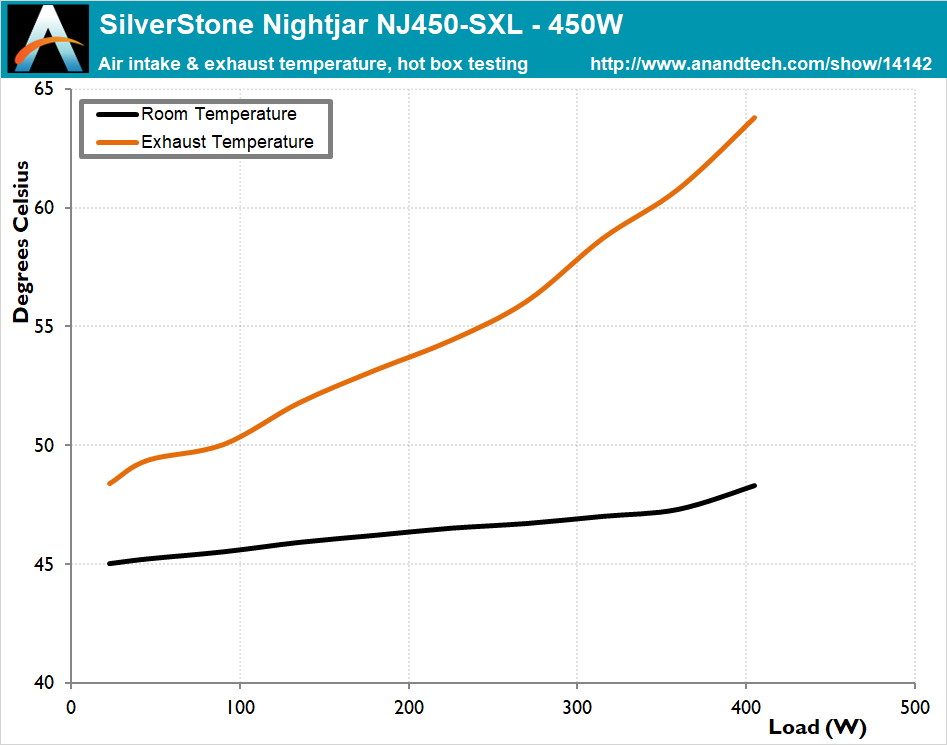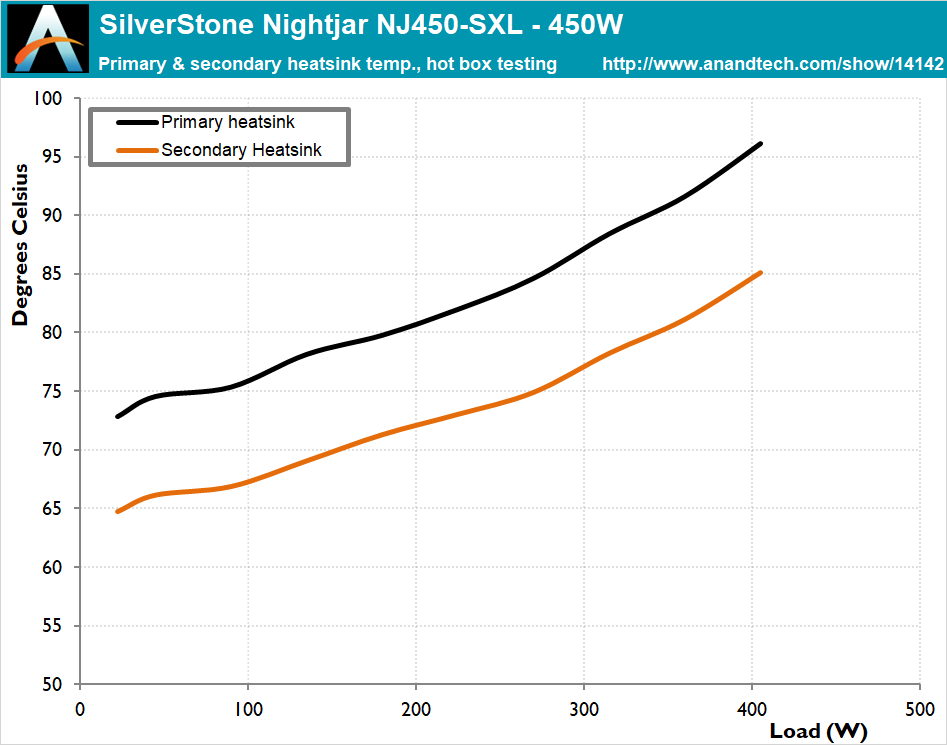The SilverStone Nightjar NJ450-SXL 450W SFX PSU Review: Passive Excellence
by E. Fylladitakis on April 4, 2019 8:00 AM EST- Posted in
- Cases/Cooling/PSUs
- PSUs
- SilverStone
- Passive Cooling
- SFX
- SFX-L
- Passive
Hot Test Results (~45°C Ambient Temperature)
Early SFX PSU designs displayed relatively poor power quality figures but we are constantly getting better and better performance figures from newer designs, indicating that manufacturers are now placing more resources on their design and development. The Nightjar NJ450-SXL feels eons ahead of the units that we reviewed merely a couple of years ago, displaying outstanding power quality figures that easily compare to those obtained from top-tier ATX units. However, we could not operate the unit stably inside our hotbox at 100% load, as the PSU would randomly shut down, therefore we were forced to limit our testing up to 90% load. SilverStone clearly states that this unit is rated for operation up to 40 °C and the high ambient temperature greatly impacts the unit’s ability to dissipate its thermal losses, so the behavior of its safety mechanism is both expected and welcome.
| Main Output | ||||||||
| Load (Watts) | 90,9 W | 227,11 W | 338,63 W | 400,78 W | ||||
| Load (Percent) | 20,2% | 50,47% | 75,25% | 89,06% | ||||
| Amperes | Volts | Amperes | Volts | Amperes | Volts | Amperes | Volts | |
| 3.3 V | 1,4 | 3,37 | 3,5 | 3,37 | 5,25 | 3,33 | 11,08 | 3,33 |
| 5 V | 1,31 | 5,05 | 3,28 | 5,02 | 4,93 | 4,99 | 10,38 | 4,97 |
| 12 V | 6,57 | 12,11 | 16,42 | 12,11 | 24,63 | 12,04 | 25,96 | 12,03 |
| Line | Regulation (20% to 100% load) |
Voltage Ripple (mV) | |||||
| 20% Load | 50% Load | 75% Load | 90% Load | CL1 12V |
CL2 3.3V + 5V |
||
| 3.3V | 1,2% | 16 | 12 | 14 | 18 | 20 | 18 |
| 5V | 1,6% | 18 | 16 | 16 | 20 | 20 | 22 |
| 12V | 0,6% | 24 | 14 | 16 | 26 | 24 | 20 |
SilverStone’s unit uniquely hits its best performance at 50% load, with the power quality figures worsening when the PSU is very lightly loaded. We recorded a maximum voltage ripple of 26 mV on the 12V line at 90% load, an impressive figure for any SFX PSU. Voltage regulation is very tight on the 12V line, at lower than 0.6% across the nominal output range. The secondary lines are not as tightly regulated, at 1.2% and 1.6% for the 3.3V and 5V lines respectively, yet these figures still are excellent by any measure.
The energy conversion efficiency of the SilverStone Nightjar NJ450-SXL takes a significant hit with the unit operating in our hotbox, a natural phenomenon considering the high internal temperatures of the unit under these operating conditions. The average efficiency reduction is 2%, equally distributed across the entire load range, suggesting that the efficiency drop is not due to the overstressing of a particular component but merely due to the high operating temperatures. Albeit the Nightjar NJ450-SXL is clearly not designed to withstand such operating conditions, it remains operable and it recovers safely from overloading/overheating conditions.














25 Comments
View All Comments
ingwe - Thursday, April 4, 2019 - link
This looks like a great PSU overall, but a passive PSU would make me pretty nervous about longevity.Exodite - Thursday, April 4, 2019 - link
I can only offer anecdotal support but I don't think you should worry about that, as long as the PSU itself is of good quality.I've been using the same Seasonic SS-FL460 (a fanless 460W, Gold-rated unit) since 2011 and while it's still powering the same i7 2600K I bought along with it it's scaled perfectly all the way up to a Vega 56, 4 HDDs and a SSD.
I don't game 24/7 by any means but even when stressing the unit as far as my setup allows (Prime95 + FurMark) it doesn't get particularly warm.
Unfortunately my particular unit isn't the perfect example of the benefits of fanless PSUs as it has some audible electrical noise under particular loads, so there's that. :)
jeremyshaw - Thursday, April 4, 2019 - link
Audible electrical noise is the exact reason I sold off my last Seasonic passive PSU. Mine made more noticeable noise than the fan did on another Seasonic PSU. Unacceptable, IMO, so I actually haven't bought another Seasonic since then (apparently a good choice, since they have since languished in PSU design, even if their quality remains reasonably high).Exodite - Thursday, April 4, 2019 - link
Completely understandable.I'm in the market for a new desktop later this year and if I end up replacing the chassi and PSU as well it probably won't be with a fanless model. Not because of any issue with passive cooling but rather the noise.
I'm still interested in Seasonic primarily I admit but since I value silence and the electrical noise of the new models are an unknown to me I'm inclined to go with a traditional solution.
FreckledTrout - Thursday, April 4, 2019 - link
I have a Seasonic Prime Ultra 850 Titanium SSR-850TR in my desktop build with a Ryzen 1800 and a GTX 1070. Having 850 watts its complete and utter overkill but it's basically fanless unit in hybrid mode for 99% of my usage and being Titanium I don't lose much efficiency running it at 25-40% of max wattage. It also has zero electrical noise that can make out even when I put me ear up to it with the fan not running I hear nothing.Exodite - Thursday, April 4, 2019 - link
Thank you, that's good information!If I do switch PSUs it's likely going to be a Titanium unit, for the 10% efficiency minimum. Hitting ideal efficiency under load is usually easy enough at any load from 25-100% but I'm hoping to improve my efficiency at idle and basic desktop use too.
A 650W Titanium unit should still be 90% efficient at 65W and that's not an unrealistic figure at the desktop, I think?
At least that's about what I'm seeing now, though obviously a more modern platform may well draw less power.
daniel78R - Thursday, April 4, 2019 - link
I have a Corsair SF600, in a FractalDesign Node 202 powering a Ryzen 1600X (with Scythe Big Suriken - modified) and GF 1060 and unless I start a game, the PSU does not start the fans, and even when it starts, it is way less noisy than CPU or GPU fans, and they are not very loud eithernagi603 - Monday, April 8, 2019 - link
> At least that's about what I'm seeing now, though obviously a more modern platform may well draw less power.Not necessarily, especially for GPUs. (1080 vs 2080 is quite a jump, 180 to 215W) The bump in core count has not resulted in lower idle draws either.
emn13 - Wednesday, April 10, 2019 - link
Although the electrical noise is major irritant for those that suffer from it, it's by no means universal, and it's not just one or two manufacturer's that have this problem. I'm pretty sure it's also not even really model-specific in the sense that even within the same model some batches are problematic, and other's aren't.Which means you might want to simply resign yourself to trying several ones, and sending bad ones back, rather than relying on trying to divine some pattern from the online reviews, many of which don't mention this at all.
tonyou - Sunday, April 7, 2019 - link
PSU electrical noises are usually high frequency noises and travel by air, so with NJ450-SXL's external aluminum heatsink shell having no vents, it actually helps reduce those noises better than any PC power supply ever could.If silence is your priority, you should give NJ450-SXL a try.